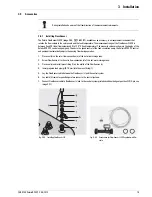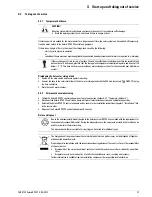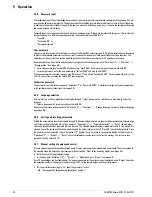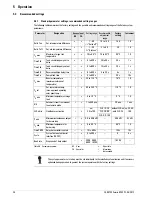
4
x
Start-up and taking out of service
23
FA ROTEX Solaris RPS3 P2 - 06/2012
4
Start-up and taking out of service
4.1
Initial start-up
4.1.1 Fill solar panel circuit
Table 4-1 Calculating pressures for start-up
1. Check that all threaded fasteners are tight.
2. Calculate the required initial pressure for the diaphragm expansion vessel (MAG) with the system unpressurised, check it
and adjust if necessary (see MAG initial pressure tab. 4-1).
3. Open ball cock ball valves of feed and return flow at the RDS1 pressure station.
4. Set the blocking of the flow meter (item 10, image 3-14) to the filling position (slot horizontal).
WARNING!
The solar system cannot be started until all hydraulic and electrical connections have been completed.
Incorrect commissioning will impair the system's function, and can lead to damage to the entire installation.
Therefore, installation and commissioning should only be carried out by heating technicians trained and
authorised by ROTEX.
CAUTION!
Danger of scalding by hot solar fluid and escaping steam.
• Only fill the solar panel circuit when there is no strong direct sunlight or only if the solar panels are
covered up.
WARNING!
If the heat transfer medium is mixed with other substances, frost and corrosion protection may be reduced.
This may damage system components.
• Conduct all work on the components of the solar system only with the solar panels covered.
• Only rinse and fill solar system with the prescribed heat exchanger fluid (e.g. ROTEX Solarfluid CORACON
SOL 5F,
16 20 52
).
• Mixing of the heat-transfer medium with other materials is not permitted. To extend frost-protection, use
a heat-transfer medium of the same value (e.g. ROTEX Solarfluid CORACON SOL 5,
16 20 53
).
WARNING!
If heat transfer media containing glycol are exposed to temperatures above 170 °C over an extended period,
they will decompose or form silt. This may reduce the frost protection, affect the output of the solar system
and damage components of the system.
• Start operation of the solar system immediately after filling it.
• Drain the system if it is to be out of operation over an extended period.
• Replace the heat transfer medium in the system before start-up after extended downtime.
MAG initial pressure
System fill pressure
Maximum system pressure
p
v
= 0.1 x h
stat
+ 0.5 bar
p
0
= p
v
+ 0.3 bar
p
e
<= 0.9 x p
sv
p
e
Maximum permissible system
pressure (warm) in bar
p
sv
Contact pressure of safety valve
(>3 bar)
p
v
Prepressure MAG in bar
(
at least 1.2 bar)
p
0
System fill pressure (cold) in bar
h
stat
Static height in m between centre of
MAG and highest system point






























